Operating Range, Performance and Emissions of an HCCI Engine Fueled with Fusel Oil/Diethyl Ether: An Experimental Study
Abstract
1. Introduction
2. Materials and Methods
3. Results
4. Discussion
Author Contributions
Funding
Informed Consent Statement
Conflicts of Interest
References
- Zeng, X.; Li, M.; Abd El-Hady, D.; Alshitari, W.; Al-Bogami, A.S.; Lu, J.; Amine, K. Commercialization of lithium battery technologies for electric vehicles. Adv. Energy Mater. 2019, 9, 1900161. [Google Scholar] [CrossRef]
- Kocakulak, T.; Solmaz, H. Control of pre and post transmission parallel hybrid vehicles with fuzzy logic method and comparison with other power systems. J. Fac. Eng. Archit. Gazi Univ. 2020, 35, 2269–2286. [Google Scholar]
- Montoya, A.; Guéret, C.; Mendoza, J.E.; Villegas, J.G. The electric vehicle routing problem with nonlinear charging function. Transp. Res. Part B Methodol. 2017, 103, 87–110. [Google Scholar] [CrossRef]
- Liu, J.; Peng, H. Modeling and control of a power-split hybrid vehicle. IEEE Trans. Control. Syst. Technol. 2008, 16, 1242–1251. [Google Scholar]
- Calam, A. Effects of the fusel oil usage in HCCI engine on combustion, performance and emission. Fuel 2020, 262, 116503. [Google Scholar] [CrossRef]
- Calam, T.T. Investigation of the electrochemical behavior of phenol using 1H-1, 2, 4-triazole-3-thiol modified gold electrode and its voltammetric determination. J. Fac. Eng. Archit. Gazi Univ. 2020, 35, 835–844. [Google Scholar]
- Tabanlıgil Calam, T. Analytical application of the poly (1H-1, 2, 4-triazole-3-thiol) modified gold electrode for high-sensitive voltammetric determination of catechol in tap and lake water samples. Int. J. Environ. Anal. Chem. 2019, 99, 1298–1312. [Google Scholar] [CrossRef]
- Calam, T.T. Electrochemical Oxidative Determination and Electrochemical Behavior of 4-Nitrophenol Based on an Au Electrode Modified with Electro-polymerized 3, 5-Diamino-1, 2, 4-triazole Film. Electroanalysis 2020, 32, 149–158. [Google Scholar] [CrossRef]
- Örs, İ.; Sayın, B.; Ciniviz, M. An Experimental Study on the Comparison of the Methanol Addition into Gasoline with the Addition of Ethanol. Int. J. Automot. Sci. Technol. 2020, 4, 59–69. [Google Scholar] [CrossRef]
- Polat, S. An experimental study on combustion, engine performance and exhaust emissions in a HCCI engine fuelled with diethyl ether–ethanol fuel blends. Fuel Process. Technol. 2016, 143, 140–150. [Google Scholar] [CrossRef]
- Solmaz, H. Combustion, performance and emission characteristics of fusel oil in a spark ignition engine. Fuel Process. Technol. 2015, 133, 20–28. [Google Scholar] [CrossRef]
- Uyumaz, A. Combustion, performance and emission characteristics of a DI diesel engine fueled with mustard oil biodiesel fuel blends at different engine loads. Fuel 2018, 212, 256–267. [Google Scholar] [CrossRef]
- Yeşilyurt, M.K.; Doğan, B.; Derviş, E.R.O.L. Experimental assessment of a CI engine operating with 1-pentanol/diesel fuel blends. Int. J. Automot. Sci. Technol. 2020, 4, 70–89. [Google Scholar] [CrossRef]
- Yılmaz, E. Investigation of the effects of diesel-fusel oil fuel blends on combustion, engine performance and exhaust emissions in a single cylinder compression ignition engine. Fuel 2019, 255, 115741. [Google Scholar] [CrossRef]
- Yılmaz, E. A Comparative Study on the Usage of RON68 and Naphtha in an HCCI Engine. Int. J. Automot. Sci. Technol. 2020, 4, 90–97. [Google Scholar] [CrossRef]
- Aydoğan, B. Experimental investigation of tetrahydrofuran combustion in homogeneous charge compression ignition (HCCI) engine: Effects of excess air coefficient, engine speed and inlet air temperature. Journal of the Energy Institute. 2020, 93, 1163–1176. [Google Scholar] [CrossRef]
- Mofijur, M.; Hasan, M.M.; Mahlia, T.M.I.; Rahman, S.A.; Silitonga, A.S.; Ong, H.C. Performance and emission parameters of homogeneous charge compression ignition (HCCI) engine: A review. Energies 2019, 12, 3557. [Google Scholar] [CrossRef]
- Hyvönen, J.; Haraldsson, G.; Johansson, B. Operating conditions using spark assisted HCCI combustion during combustion mode transfer to SI in a multi-cylinder VCR-HCCI engine. In SAE Technical Paper 2005-01-0109; SAE: Warrendale, PA, USA, 2005. [Google Scholar]
- Cinar, C.; Uyumaz, A.; Solmaz, H.; Topgul, T. Effects of valve lift on the combustion and emissions of a HCCI gasoline engine. Energy Convers. Manag. 2015, 94, 159–168. [Google Scholar] [CrossRef]
- Cinar, C.; Uyumaz, A.; Solmaz, H.; Sahin, F.; Polat, S.; Yilmaz, E. Effects of intake air temperature on combustion, performance and emission characteristics of a HCCI engine fueled with the blends of 20% n-heptane and 80% isooctane fuels. Fuel Process. Technol. 2015, 130, 275–281. [Google Scholar] [CrossRef]
- Rather, M.A.; Wani, M.M. A numerical study on the effects of exhaust gas recirculation temperature on controlling combustion and emissions of a diesel engine running on HCCI combustion mode. Int. J. Automot. Sci. Technol. 2018, 2, 17–27. [Google Scholar] [CrossRef][Green Version]
- Ferguson, C.R.; Kirkpatrick, A.T. Internal Combustion Engines: Applied Thermosciences; John Wiley & Sons: Hoboken, NJ, USA, 2015. [Google Scholar]
- Halis, S.; Nacak, Ç.; Solmaz, H.; Yilmaz, E.; Yucesu, H.S. Investigation of the effects of octane number on combustion characteristics and engine performance in a HCCI engine. J. Therm. Sci. Technol. 2018, 38, 73–84. [Google Scholar]
- Heywood, J.B. Internal Combustion Engine Fundamentals; McGraw-Hill Education: New York, NY, USA, 2018. [Google Scholar]
- Aydoğan, B. Combustion, Performance and Emissions of Ethanol/n-Heptane Blends in HCCI Engine. Engineering Perspective. 2021, 1, 6–10. [Google Scholar] [CrossRef]
- Antunes, J.G.; Mikalsen, R.; Roskilly, A.P. An investigation of hydrogen-fuelled HCCI engine performance and operation. Int. J. Hydrog. Energy 2008, 33, 5823–5828. [Google Scholar]
- Soyhan, H.S.; Yasar, H.; Walmsley, H.; Head, B.; Kalghatgi, G.T.; Sorusbay, C. Evaluation of heat transfer correlations for HCCI engine modeling. Appl. Therm. Eng. 2009, 29, 541–549. [Google Scholar] [CrossRef]
- Starck, L.; Lecointe, B.; Forti, L.; Jeuland, N. Impact of fuel characteristics on HCCI combustion: Performances and emissions. Fuel 2010, 89, 3069–3077. [Google Scholar] [CrossRef]
- Bendu, H.; Murugan, S. Homogeneous charge compression ignition (HCCI) combustion: Mixture preparation and control strategies in diesel engines. Renew. Sustain. Energy Rev. 2014, 38, 732–746. [Google Scholar] [CrossRef]
- Zhao, H. HCCI and CAI Engines for the Automotive Industry; Elsevier: Amsterdam, The Netherlands, 2007. [Google Scholar]
- Solmaz, H A comparative study on the usage of fusel oil and reference fuels in an HCCI engine at different compression ratios. Fuel 2020, 273, 117775.
- Awad, O.I.; Ali, O.M.; Mamat, R.; Abdullah, A.; Najafi, G.; Kamarulzaman, M.; Yusri, I.; Noor, M. Using fusel oil as a blend in gasoline to improve SI engine efficiencies: A comprehensive review. Renew. Sustain. Energy Rev. 2017, 69, 1232–1242. [Google Scholar] [CrossRef]
- Awad, O.I.; Mamat, R.; Ali, O.M.; Yusri, I.M.; Abdullah, A.A.; Yusop, A.F.; Noor, M.M. The effect of adding fusel oil to diesel on the performance and the emissions characteristics in a single cylinder CI engine. J. Energy Inst. 2017, 90, 382–396. [Google Scholar] [CrossRef]
- Calam, A.; Solmaz, H.; Uyumaz, A.; Polat, S.; Yilmaz, E.; İçingür, Y. Investigation of usability of the fusel oil in a single cylinder spark ignition engine. J. Energy Inst. 2015, 88, 258–265. [Google Scholar] [CrossRef]
- Abdalla, A.N.; Ali, O.M.; Awad, O.I.; Tao, H. Wavelet analysis of an SI engine cycle-to-cycle variations fuelled with the blending of gasoline-fusel oil at a various water content. Energy Convers. Manag. 2019, 183, 746–752. [Google Scholar] [CrossRef]
- Abdalla, A.N.; Awad, O.I.; Tao, H.; Ibrahim, T.K.; Mamat, R.; Hammid, A.T. Performance and emissions of gasoline blended with fusel oil that a potential using as an octane enhancer. Energy Sources Part A Recovery Util. Environ. Eff. 2019, 41, 931–947. [Google Scholar] [CrossRef]
- Abdalla, A.N.; Tao, H.; Bagaber, S.A.; Ali, O.M.; Kamil, M.; Ma, X.; Awad, O.I. Prediction of emissions and performance of a gasoline engine running with fusel oil–Gasoline blends using response surface methodology. Fuel 2019, 253, 1–14. [Google Scholar] [CrossRef]
- Awad, O.I.; Mamat, R.B.; Ali, O.M.; Yusri, I.M. Effect of fuel oil-gasoline fusel blends on the performance and emission characteristics of spark ignition engine: A review. J. Sci. Res. Dev. 2016, 3, 31–36. [Google Scholar]
- Awad, O.I.; Mamat, R.; Ibrahim, T.K.; Hagos, F.Y.; Noor, M.M.; Yusri, I.M.; Leman, A.M. Calorific value enhancement of fusel oil by moisture removal and its effect on the performance and combustion of a spark ignition engine. Energy Convers. Manag. 2017, 137, 86–96. [Google Scholar] [CrossRef]
- Awad, O.I.; Mamat, R.; Noor, M.M.; Yusop, F.; Yusri, I.M. The Impacts of Moisture Content on Performance and Emissions of a Four-Cylinder SI Engine Running with Fuse Oil-Gasoline Blends. WSEAS Trans. Environ. Dev. 2017, 13, 120–128. [Google Scholar]
- Awad, O.I.; Mamat, R.; Ibrahim, T.K.; Ali, O.M.; Kadirgama, K.; Leman, A.M. Performance and combustion characteristics of an SI engine fueled with fusel oil-gasoline at different water content. Appl. Therm. Eng. 2017, 123, 1374–1385. [Google Scholar] [CrossRef]
- Awad, O.I.; Mamat, R.; Ali, O.M.; Azmi, W.H.; Kadirgama, K.; Yusri, I.M.; Leman, A.M.; Yusaf, T. Response surface methodology (RSM) based multi-objective optimization of fusel oil-gasoline blends at different water content in SI engine. Energy Convers. Manag. 2017, 150, 222–241. [Google Scholar] [CrossRef]
- Awad, O.I.; Mamat, R.; Ibrahim, T.K.; Kettner, M.; Kadirgama, K.; Leman, A.M.; Saiful, A.I.M. Effects of fusel oil water content reduction on fuel properties, performance and emissions of SI engine fueled with gasoline-fusel oil blends. Renew. Energy 2018, 118, 858–869. [Google Scholar] [CrossRef]
- Awad, O.I.; Ali, O.M.; Hammid, A.T.; Mamat, R. Impact of fusel oil moisture reduction on the fuel properties and combustion characteristics of SI engine fueled with gasoline-fusel oil blends. Renew. Energy 2018, 123, 79–91. [Google Scholar] [CrossRef]
- Calam, A.; İçingür, Y.; Solmaz, H.; Yamık, H. A comparison of engine performance and the emission of fusel oil and gasoline mixtures at different ignition timings. Int. J. Green Energy 2015, 12, 767–772. [Google Scholar] [CrossRef]
- Cataluña, R.; da Silva, R.; de Menezes, E.W.; Ivanov, R.B. Specific consumption of liquid biofuels in gasoline fuelled engines. Fuel 2008, 87, 3362–3368. [Google Scholar] [CrossRef]
- Icingur, Y.; Calam, A. The effects of the blends of fusel oil and gasoline on performance and emissions in a spark ignition engine. J. Fac. Eng. Archit. Gazi Univ. 2012, 27, 143–149. [Google Scholar]
- Karaosmanoglu, F. Evaluation of Alcohol—Gasoline Blends as Engine Fuel Alternative. Ph.D. Thesis, Istanbul Technical University, Istanbul, Turkey, 1990. (In Turkish). [Google Scholar]
- Karaosmanoğlu, F.; Işiğigür, A.; Aksoy, H.A. Methanol-unleaded gasoline blends containing fusel oil fraction as spark ignition engine fuel. Energy Sources 1997, 19, 567–577. [Google Scholar] [CrossRef]
- Rosdia, S.M.; Mamata, R.; Azri, A.; Sudhakar, K.; Yusri, I.M. Evaluation of properties on performance and emission to turbocharged SI engine using fusel oil blend with gasoline. IOP Conf. Ser. Mater. Sci. Eng. 2019, 469, 012113. [Google Scholar] [CrossRef]
- Aydoğan, B. Combustion characteristics, performance and emissions of an acetone/n-heptane fuelled Homogenous Charge Compression Ignition (HCCI) engine. Fuel. 2020, 275, 117840. [Google Scholar] [CrossRef]
- Simsek, S.; Ozdalyan, B. Improvements to the composition of fusel oil and analysis of the effects of fusel oil–gasoline blends on a spark-ignited (SI) engine’s performance and emissions. Energies 2018, 11, 625. [Google Scholar] [CrossRef]
- Şimşek, S.; Özdalyan, B.; Saygın, H. Improvement of the properties of sugar factory fusel oil waste and investigation of its effect on the performance and emissions of spark ignition engine. BioResources 2019, 14, 440–452. [Google Scholar] [CrossRef]
- Şimşek, S.; Saygın, H.; Özdalyan, B. Improvement of fusel oil features and effect of its use in different compression ratios for an SI engine on performance and emission. Energies 2020, 13, 1824. [Google Scholar] [CrossRef]
- Uslu, S.; Celik, M.B. Combustion and emission characteristics of isoamyl alcohol-gasoline blends in spark ignition engine. Fuel 2020, 262, 116496. [Google Scholar] [CrossRef]
- Ağbulut, Ü.; Sarıdemir, S.; Karagöz, M. Experimental investigation of fusel oil (isoamyl alcohol) and diesel blends in a CI engine. Fuel 2020, 267, 117042. [Google Scholar] [CrossRef]
- Akar, M.A.; Yilmaz, A.; Bas, O.; Keskin, A. Performance and exhaust emissions of diesel engine fueled with Fusel Oil. J. Biotechnol. 2016, 231, S48. [Google Scholar] [CrossRef]
- Akcay, M.; Ozer, S. Experimental investigation on performance and emission characteristics of a CI diesel engine fueled with fusel oil/diesel fuel blends. Energy Sources Part A Recovery Util. Environ. Eff. 2019, 2019, 1–16. [Google Scholar] [CrossRef]
- Awad, O.I.; Mamat, R.; Ali, O.M.; Othman, M.F.; Abdullah, A.A. Experimental study of performance and emissions of fusel oil-diesel blend in a single cylinder diesel engine. Int. J. Eng. Technol. 2017, 9, 138. [Google Scholar] [CrossRef]
- Awad, O.I.; Mamat, R.; Noor, M.M.; Ibrahim, T.K.; Yusri, I.M. Performance, combustion characteristics and emission tests of single cylinder engine running on fusel oil-diesel blended (F20) fuel. Int. J. Veh. Struct. Syst. 2017, 9, 195–198. [Google Scholar]
- Buravannint, S. Effect of Fusel Oil on Polycyclic Aromatic Hydrocarbons from Exhaust Emission of Diesel Engine; Chulalongkorn University: Bangkok, Thailand, 1998. [Google Scholar]
- Pour, A.H.; Ardebili, S.M.S.; Sheikhdavoodi, M.J. Multi-objective optimization of diesel engine performance and emissions fueled with diesel-biodiesel-fusel oil blends using response surface method. Environ. Sci. Pollut. Res. 2018, 25, 35429–35439. [Google Scholar] [CrossRef]
- Minja, R.J.; Mlay, H.; Katima, J.H. Plant Oil/Fusel Oil Blends as Alternative Fuels in Low-and Medium Speed Diesel Engines. Am. J. Energy Sci. 2015, 2, 9–16. [Google Scholar]
- Ashraf, M. Summarizing on the Effect of Adding Fusel Oil to Diesel on the Performance and the Emissions Characteristics in a Single Cylinder CI Engine; Mechanical System Design, Universiti Malaysia Pahang: Pekan, Malaysia, 2016. [Google Scholar]
- Mhassan, O. Mechanical System Design Performance and Emission Parameters of Single Cylinder Diesel Engine Using Fusel Oil-Diesel Blend; Mechanical System Design, Universiti Malaysia Pahang: Pekan, Malaysia, 2016. [Google Scholar]
- Ardebili, S.M.S.; Taghipoor, A.; Solmaz, H.; Mostafaei, M. The effect of nano-biochar on the performance and emissions of a diesel engine fueled with fusel oil-diesel fuel. Fuel 2020, 268, 117356. [Google Scholar]
- Safieddin Ardebili, S.M.; Zaki Dizaji, H.; Sheikh Davoodi, M.J. Optimization of performance and Emission Characteristic of Fusel Oil–Diesel blends Using Response Surface Methodology. Fuel Combust. 2018, 10, 93–104. [Google Scholar]
- Kryshtopa, S.; Kryshtopa, L.; Melnyk, V.; Dolishnii, B.; Prunko, I.; Demianchuk, Y. Experimental research on diesel engine working on a mixture of diesel fuel and fusel oils. Transp. Probl. 2017, 12, 53–63. [Google Scholar] [CrossRef]
- Sudheesh, K.; Mallikarjuna, J.M. Diethyl ether as an ignition improver for biogas homogeneous charge compression ignition (HCCI) operation-An experimental investigation. Energy 2010, 35, 3614–3622. [Google Scholar] [CrossRef]
- Paul, A.; Bose, P.K.; Panua, R.; Debroy, D. Study of performance and emission characteristics of a single cylinder CI engine using diethyl ether and ethanol blends. J. Energy Inst. 2015, 88, 1–10. [Google Scholar] [CrossRef]
- Rakopoulos, D.C.; Rakopoulos, C.D.; Giakoumis, E.G.; Dimaratos, A.M. Characteristics of performance and emissions in high-speed direct injection diesel engine fueled with diethyl ether/diesel fuel blends. Energy 2012, 43, 214–224. [Google Scholar] [CrossRef]
- Cinar, C.; Can, Ö.; Sahin, F.; Yucesu, H.S. Effects of premixed diethyl ether (DEE) on combustion and exhaust emissions in a HCCI-DI diesel engine. Appl. Therm. Eng. 2010, 30, 360–365. [Google Scholar] [CrossRef]
- Polat, S. An experimental investigation on combustion, performance and ringing operation characteristics of a low compression ratio early direct injection HCCI engine with ethanol fuel blends. Fuel 2020, 277, 118092. [Google Scholar] [CrossRef]
- Kodavasal, J.; Lavoie, G.A.; Assanis, D.N.; Martz, J.B. The effects of thermal and compositional stratification on the ignition and duration of homogeneous charge compression ignition combustion. Combust. Flame 2015, 162, 451–461. [Google Scholar] [CrossRef]
- Uyumaz, A. An experimental investigation into combustion and performance characteristics of an HCCI gasoline engine fueled with n-heptane, isopropanol and n-butanol fuel blends at different inlet air temperatures. Energy Convers. Manag. 2015, 98, 199–207. [Google Scholar] [CrossRef]
- Johansson, T.; Johansson, B.; Tunestål, P.; Aulin, H. HCCI Operating Range in a Turbo-Charged Multi Cylinder Engine with VVT and Spray-Guided DI; SAE World Congress: Warrendale, PA, USA, 2009; pp. 1–13. [Google Scholar]
- Zheng, M.; Han, X.; Asad, U.; Wang, J. Investigation of butanol-fuelled HCCI combustion on a high efficiency diesel engine. Energy Convers. Manag. 2015, 98, 215–224. [Google Scholar] [CrossRef]
- Aydoğan, B. An experimental examination of the effects of n-hexane and n-heptane fuel blends on combustion, performance and emissions characteristics in a HCCI engine. Energy 2020, 192, 116600. [Google Scholar] [CrossRef]
- Aceves, S.M.; Flowers, D.L.; Westbrook, C.K.; Smith, J.R.; Pitz, W.; Dibble, R.; Christensen, M.; Johansson, B. A multi-zone model for prediction of HCCI combustion and emissions. SAE Trans. 2000, 109, 431–441. [Google Scholar]
- Epping, K.; Aceves, S.; Bechtold, R.; Dec, J.E. The Potential of HCCI Combustion for High Efficiency and Low Emissions; SAE Technical Paper No. 2002-01-1923; SAE: Warrendale, PA, USA, 2002. [Google Scholar]
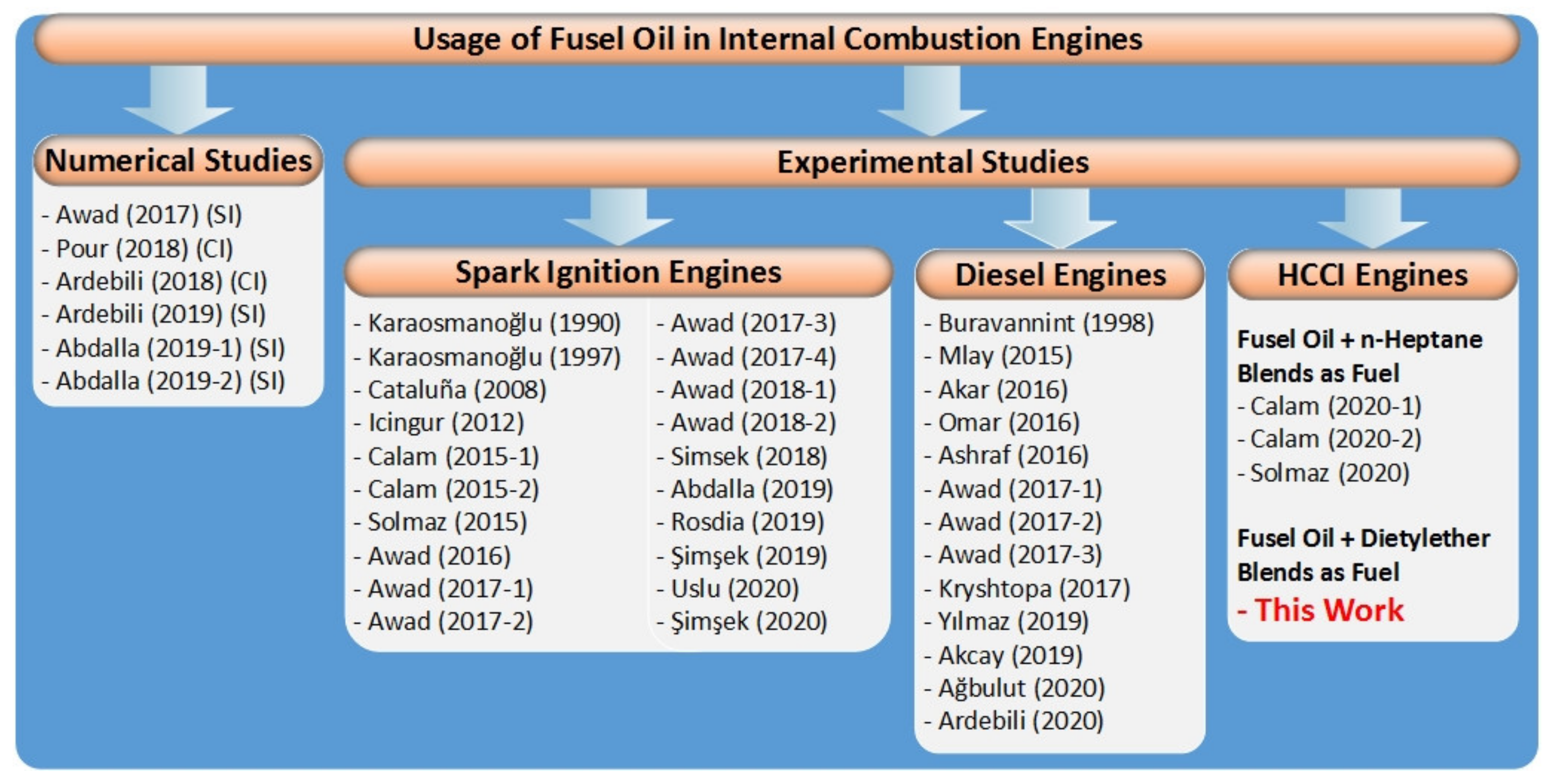
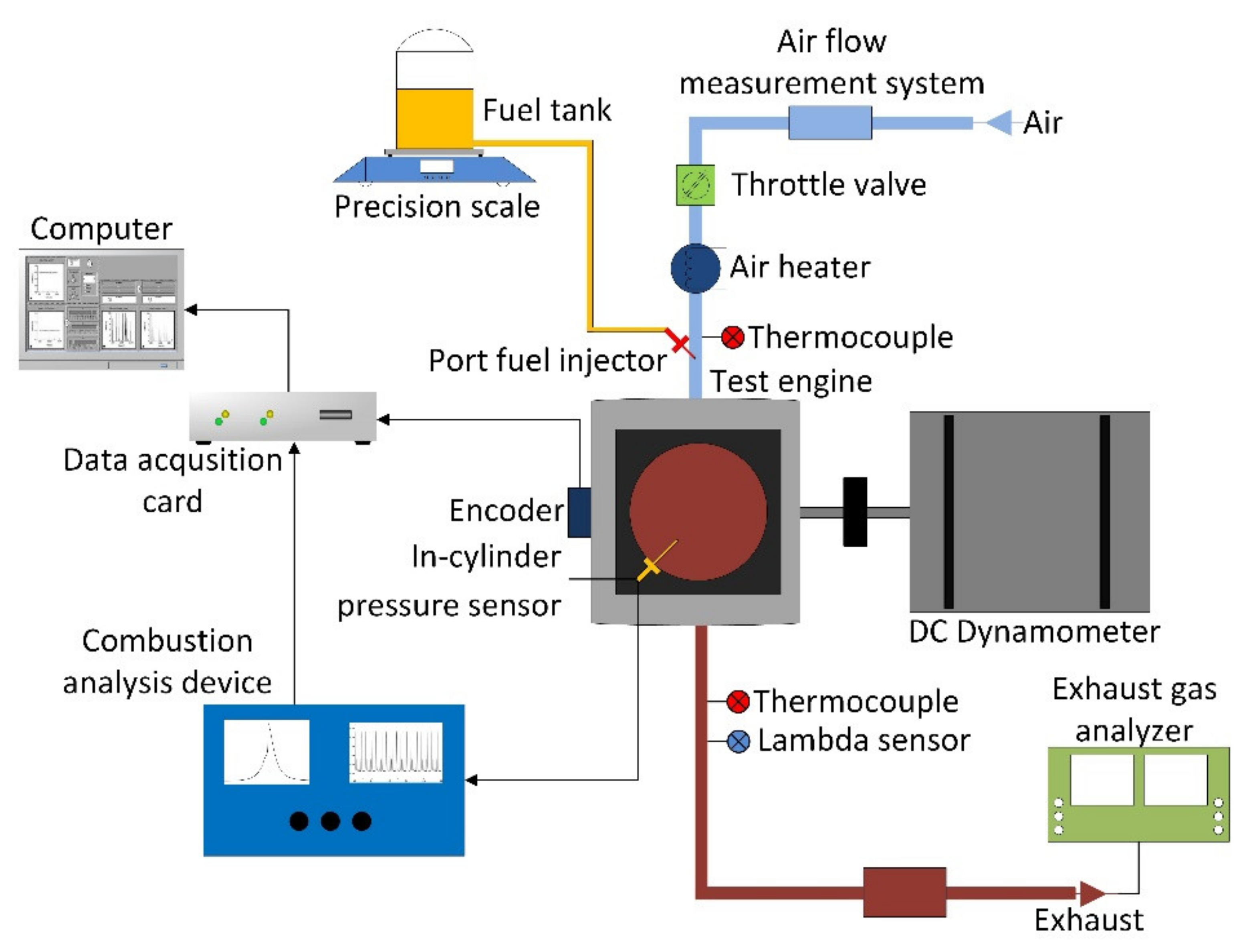
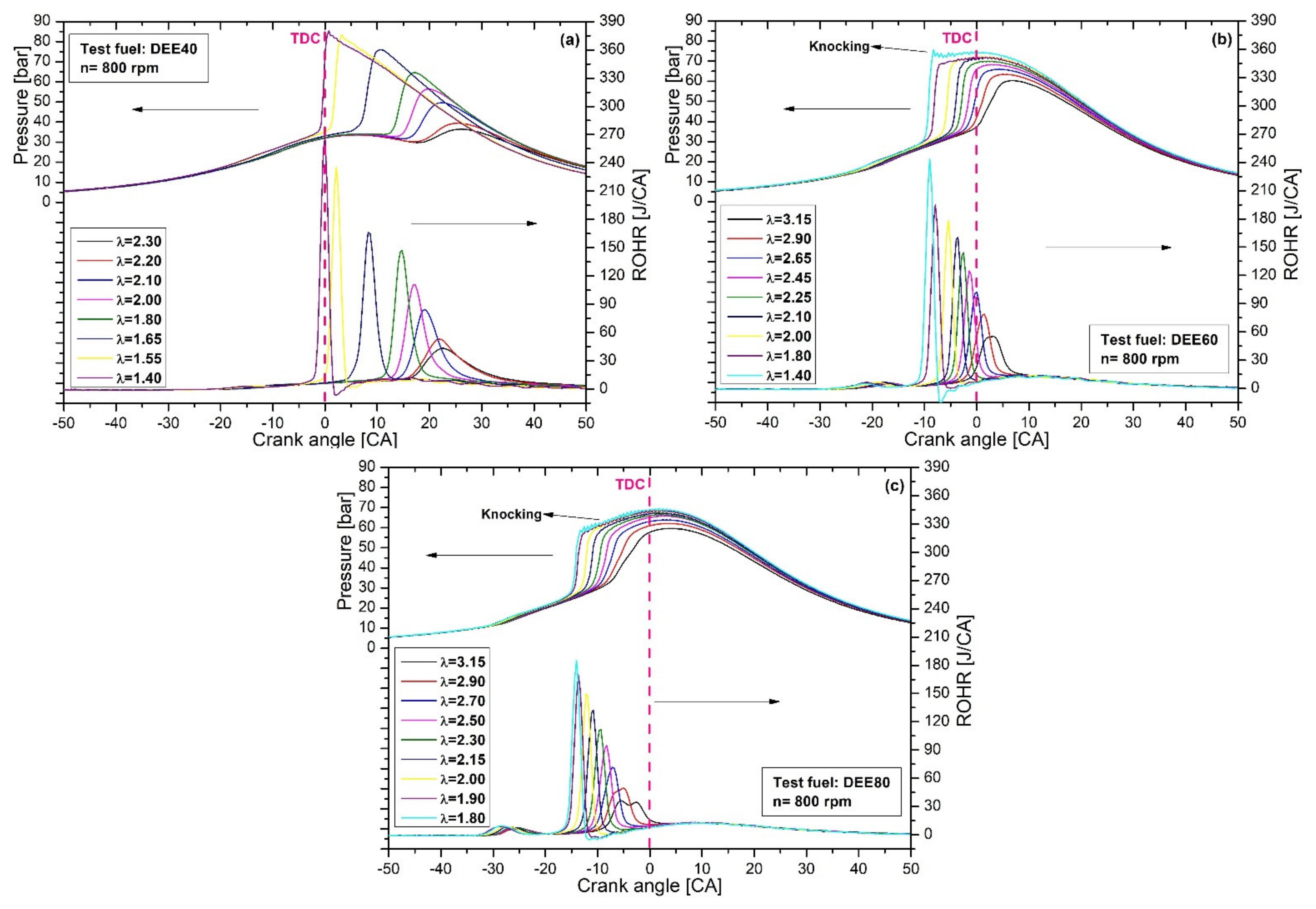
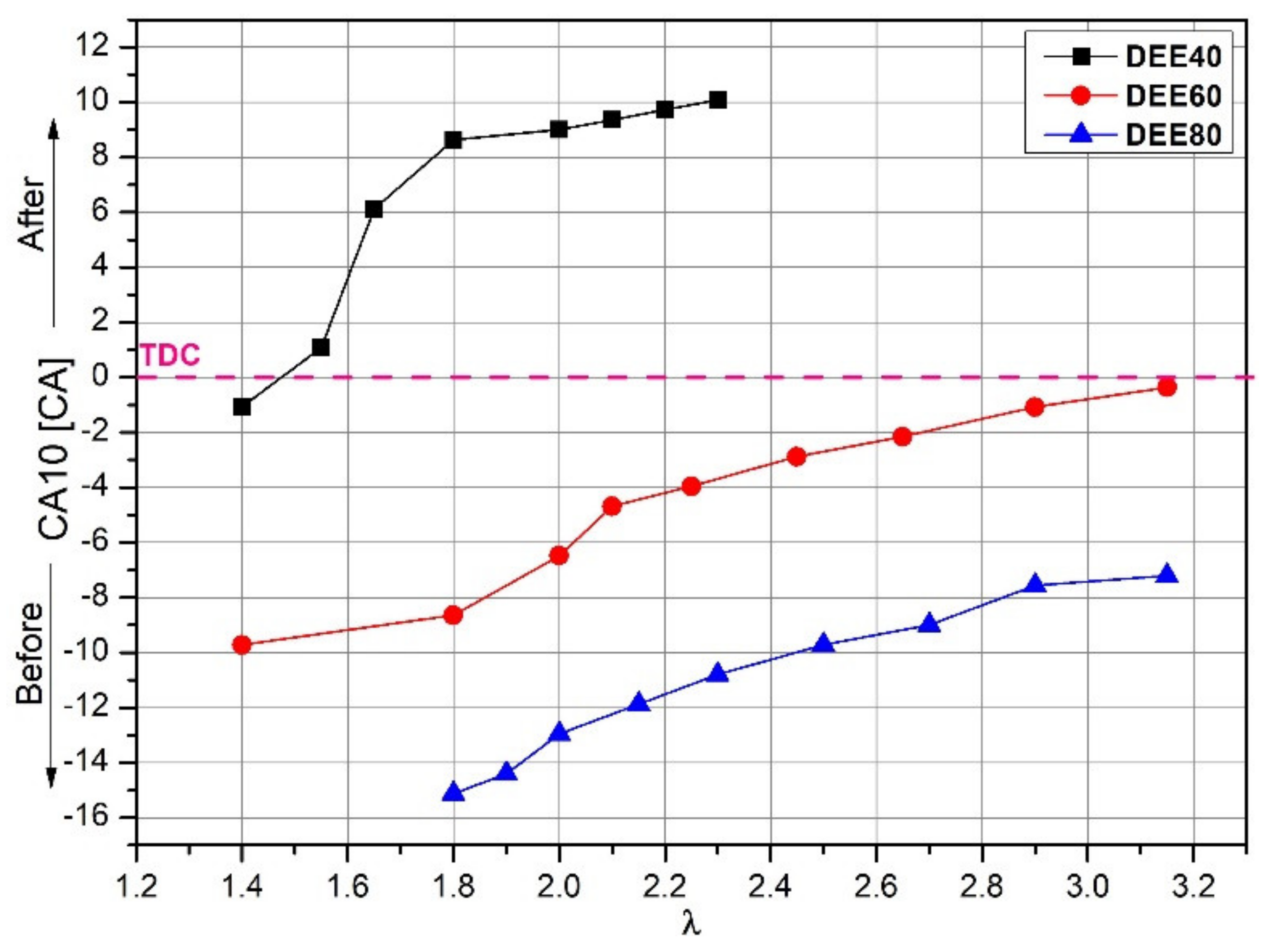

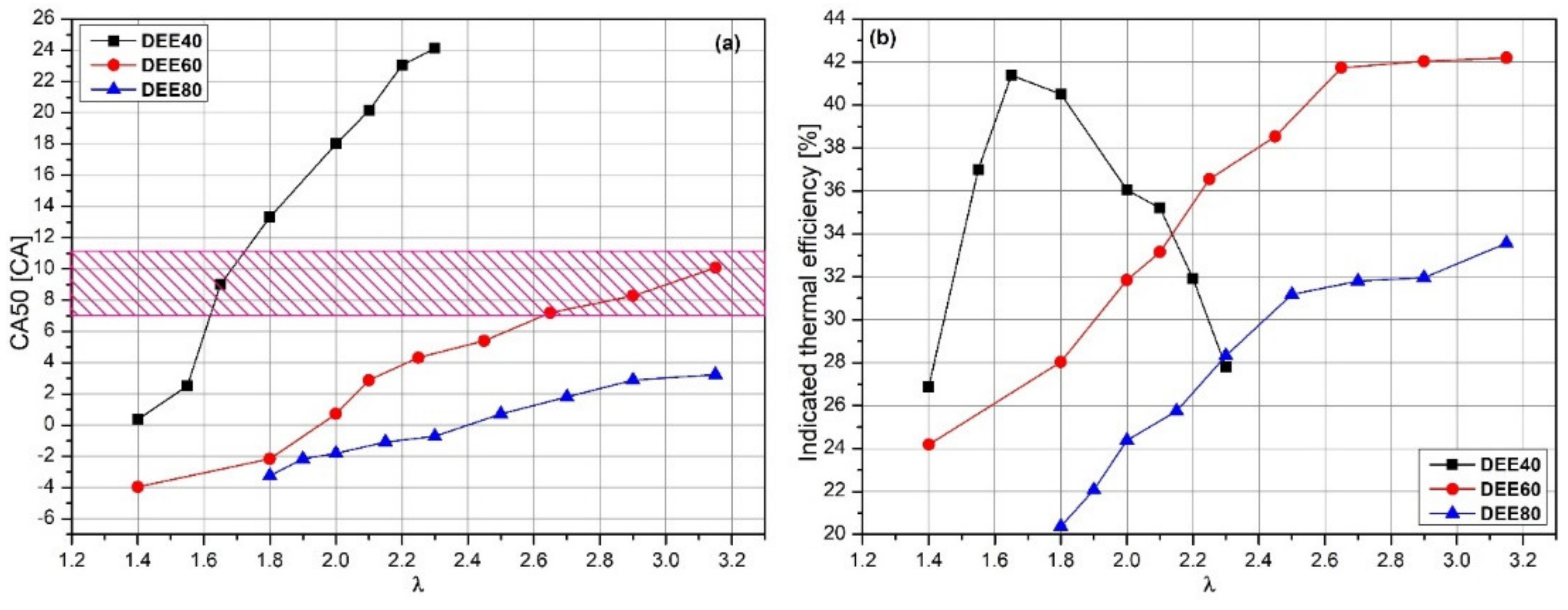
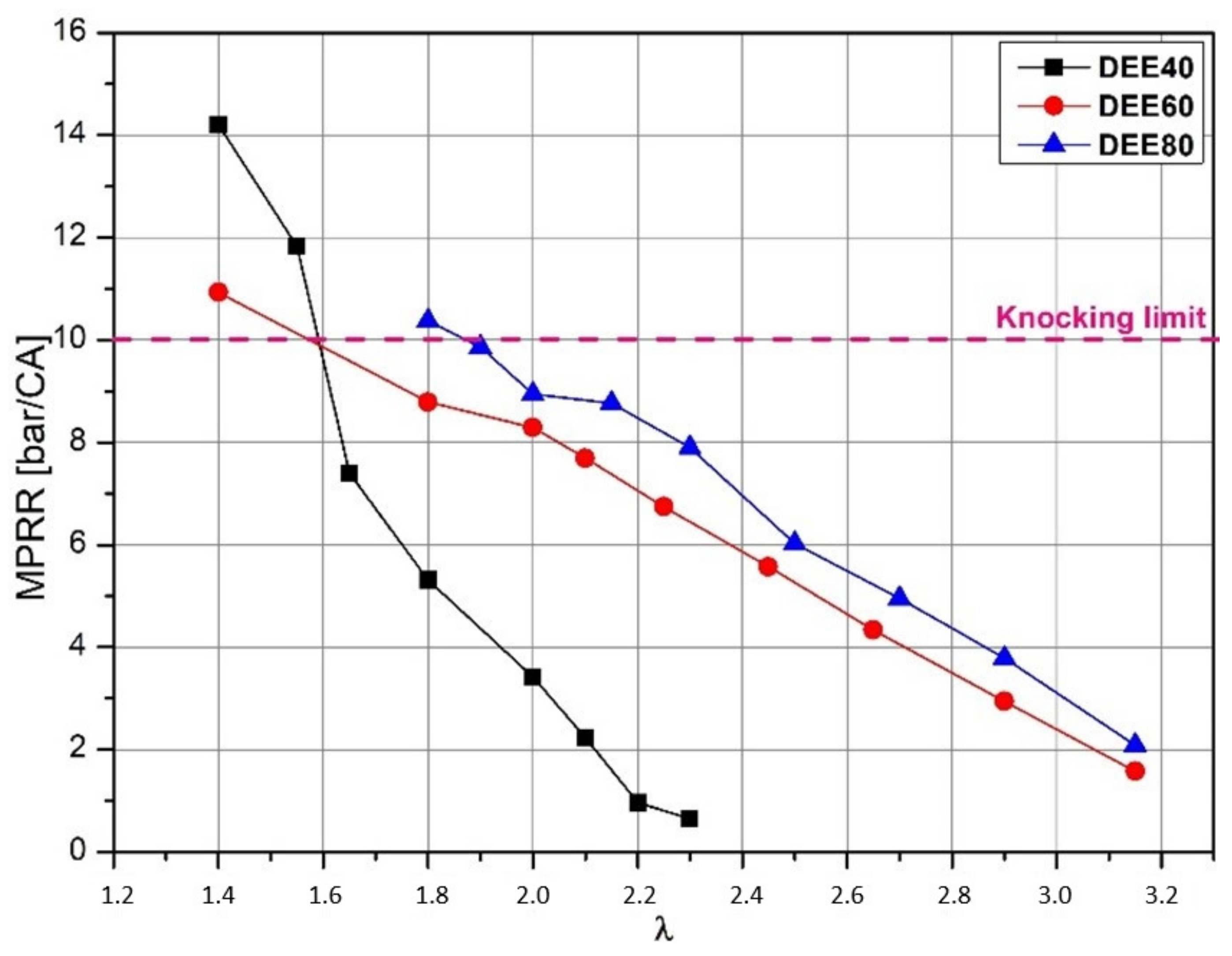
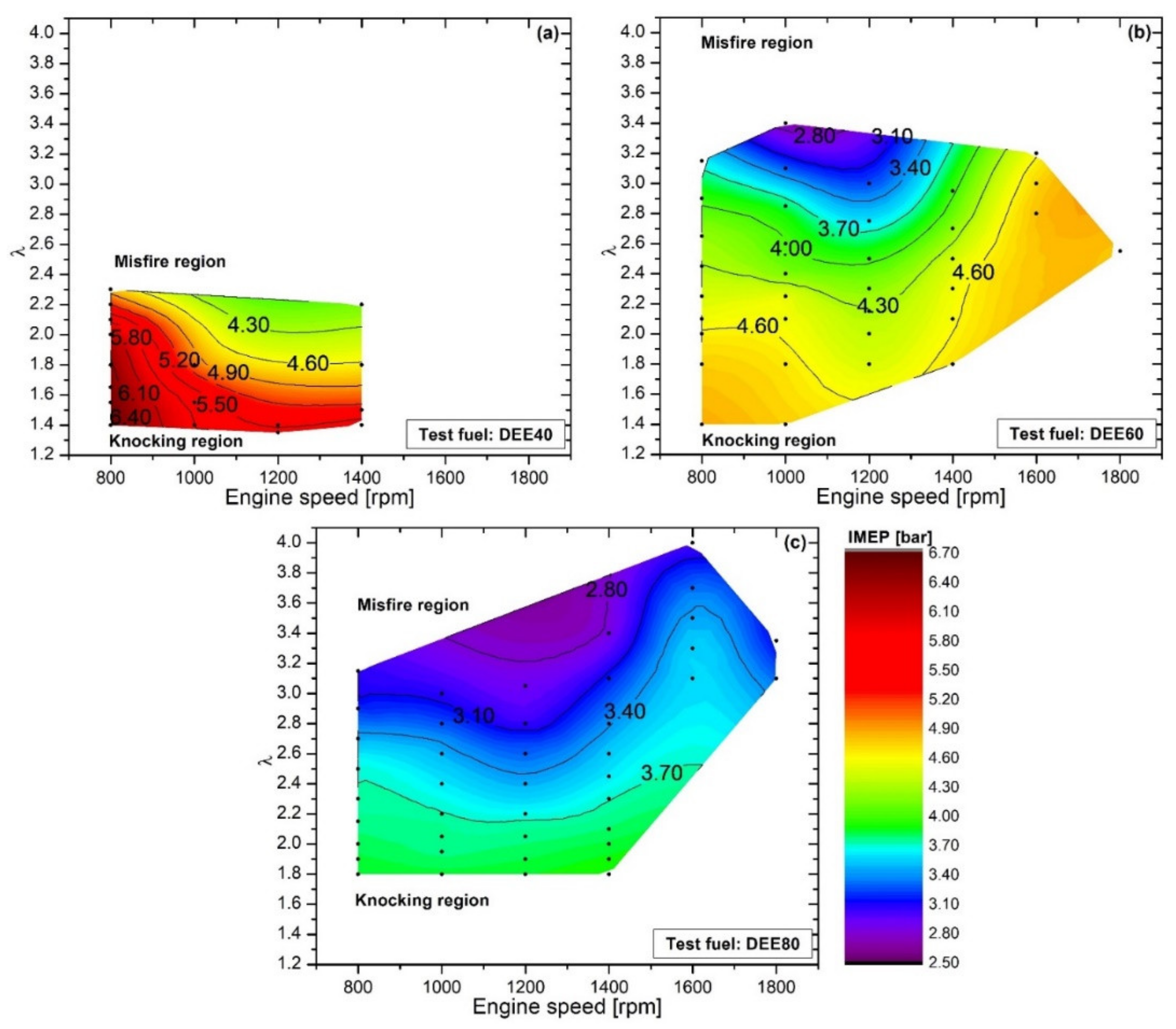
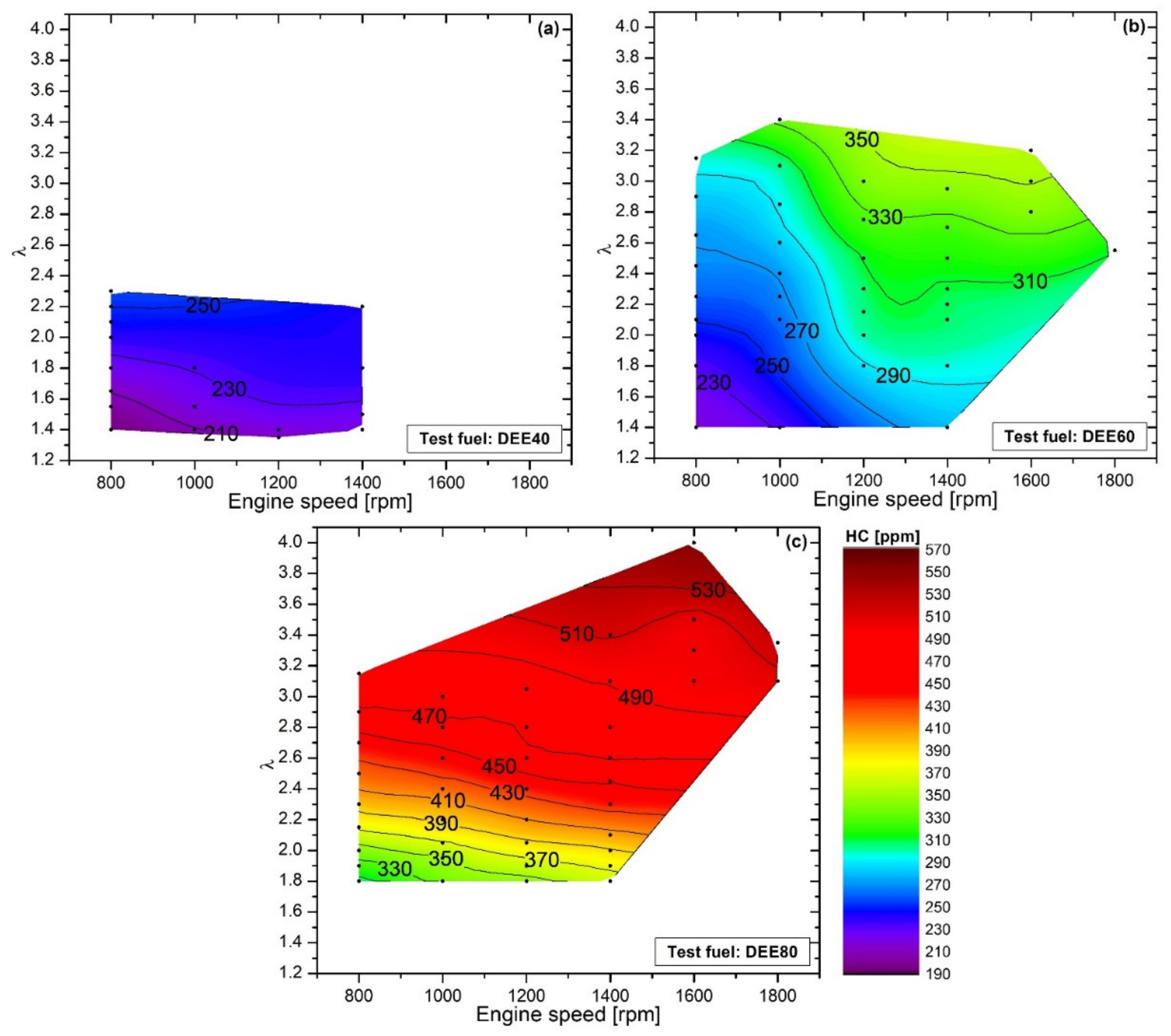
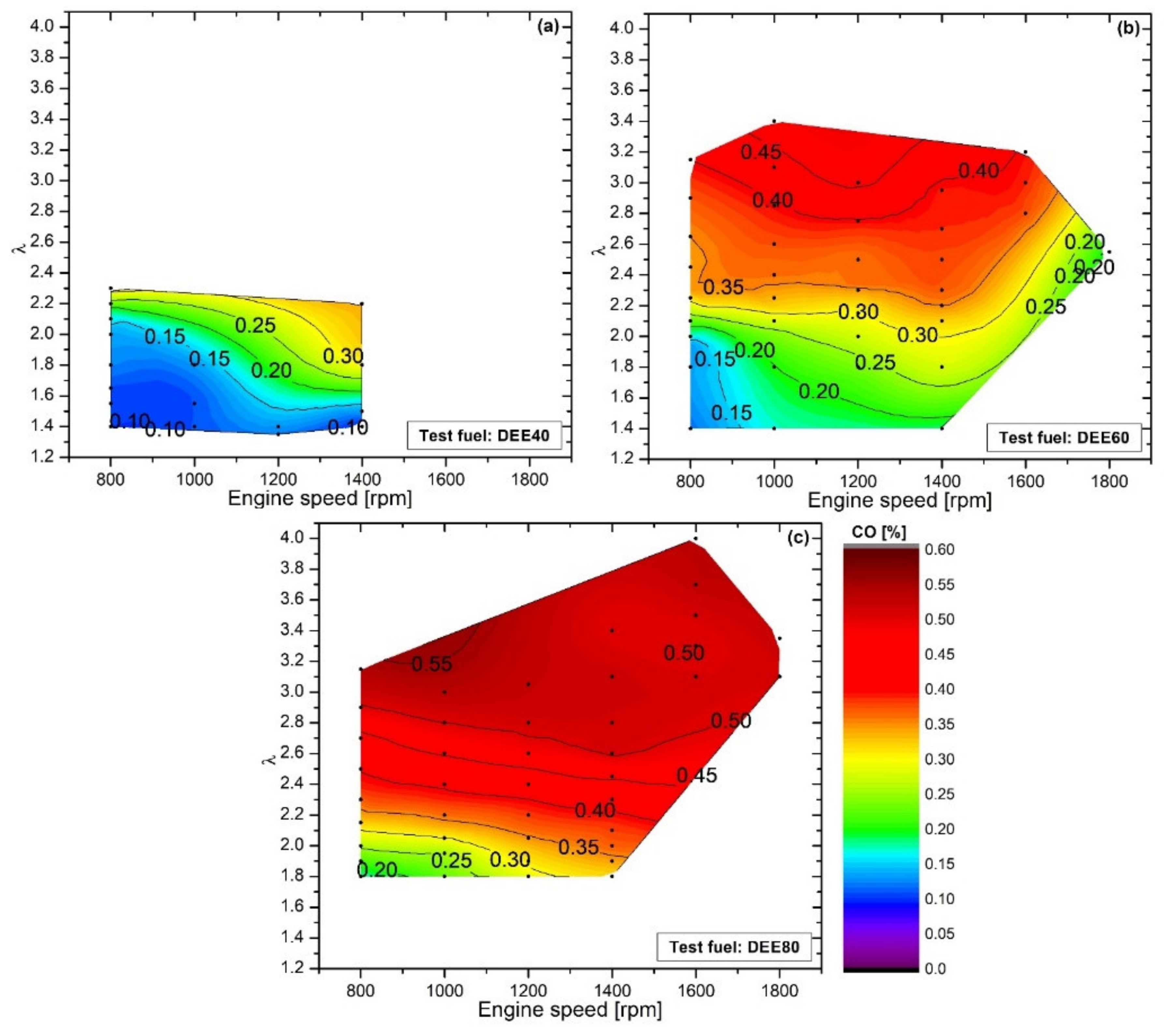
| Test Engine | Ricardo Hydra |
|---|---|
| Number of cylinders | 1 |
| Combustion mode | HCCI |
| Valve lifts Intake-Exhaust [mm] | 5.5–3.5 |
| Compression ratio | 13 |
| Bore [mm] × Stroke [mm] | 80.26 × 88.90 |
| Swept volume [cm3] | 540 |
| Maximum power output (kW) | 15 |
| Intake valve O/C timing | 12° bTDC 56° aBDC |
| Exhaust valve O/C timing | 56° bBDC 12° aTDC |
| Port injection pressure (bar) | 2.8 |
| Cylinder Pressure Transducer | Kistler 6121 Piezo Electric |
|---|---|
| Operating range (bar) | 0–250 |
| Measurement precision (pC/bar) | 14.7 |
| Operating temperature (°C) | −50 to 350 |
| Accuracy (+/− %) | 0.5 |
| Operating Range | Accuracy | |
|---|---|---|
| Lambda | 0.5–9.999 | ±0.001 |
| NO (ppm vol) | 0–5000 | ±1 |
| CO (% vol) | 0–10 | ±0.001 |
| O2 (% vol) | 0–22 | ±0.01 |
| HC (ppm vol) | 0–9999 | ±1 |
| Constituent | Chemical Formula | Molecular Weight (g/mol) | Density (g/cm3) | Boiling Point (°C) | Freezing Point (°C) | Volumetric (%) |
|---|---|---|---|---|---|---|
| i-amyl alcohol | C5H12O | 88.148 | 0.8104 | 131.1 | −117.2 | 63.03 |
| i-butyl alcohol | C4H10O | 74.122 | 0.802 | 108 | −108 | 16.16 |
| n-butyl alcohol | C4H10O | 74.122 | 0.8098 | 117.73 | −89.5 | 0.686 |
| n-propyl alkyl | C3H8O | 60.09 | 0.8034 | 97.1 | −126.5 | 0.688 |
| Ethanol | C2H6O | 46.07 | 0.789 | 78.4 | −114.3 | 9.236 |
| Water | H2O | 18 | 1 | 100 | 0 | 10.2 |
| Test Parameters | Value/Description |
|---|---|
| Engine speed | 800–1800 (rpm) |
| Combustion mode | HCCI |
| Fuel type | DEE40-DEE60-DEE80 |
| IAT | 353 (K) |
| Lambda range | 1.4–4.0 |
| Engine oil temperature | 60 °C |
| Engine water temperature | 65 °C |
Publisher’s Note: MDPI stays neutral with regard to jurisdictional claims in published maps and institutional affiliations. |
© 2022 by the authors. Licensee MDPI, Basel, Switzerland. This article is an open access article distributed under the terms and conditions of the Creative Commons Attribution (CC BY) license (https://creativecommons.org/licenses/by/4.0/).
Share and Cite
Polat, S.; Calam, A.; Ardebili, S.M.S.; Şahin, F.; Boroiu, A.A.; Solmaz, H. Operating Range, Performance and Emissions of an HCCI Engine Fueled with Fusel Oil/Diethyl Ether: An Experimental Study. Sustainability 2022, 14, 15666. https://doi.org/10.3390/su142315666
Polat S, Calam A, Ardebili SMS, Şahin F, Boroiu AA, Solmaz H. Operating Range, Performance and Emissions of an HCCI Engine Fueled with Fusel Oil/Diethyl Ether: An Experimental Study. Sustainability. 2022; 14(23):15666. https://doi.org/10.3390/su142315666
Chicago/Turabian StylePolat, Seyfi, Alper Calam, Seyed Mohammad Safieddin Ardebili, Fatih Şahin, Alexandru Andrei Boroiu, and Hamit Solmaz. 2022. "Operating Range, Performance and Emissions of an HCCI Engine Fueled with Fusel Oil/Diethyl Ether: An Experimental Study" Sustainability 14, no. 23: 15666. https://doi.org/10.3390/su142315666
APA StylePolat, S., Calam, A., Ardebili, S. M. S., Şahin, F., Boroiu, A. A., & Solmaz, H. (2022). Operating Range, Performance and Emissions of an HCCI Engine Fueled with Fusel Oil/Diethyl Ether: An Experimental Study. Sustainability, 14(23), 15666. https://doi.org/10.3390/su142315666











